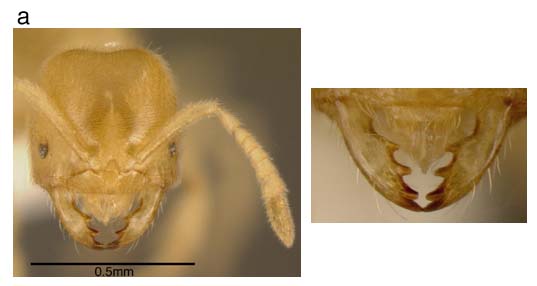
| Genus List | Species List |Acropyga Overview |
10a. Basal tooth of mandible greatly enlarged, roughly rectangular in shape; antennae with 8 segments, with apical segment greatly enlarged, twice as wide as other segments and almost as long as all other funicular segments combined: panamensis
10b. Basal tooth of mandible not enlarged, roughly triangular in shape; antennae with 7-11 segments, with apical segment not greatly enlarged: 20

20a. Smaller species (TL: less than 1.7mm); head width less than 0.4mm: smithii
20b. Larger species (TL usually greater than 1.7mm); head width greater than 0.4mm: 50
50a Antennae with 8 segments; mandible with 4 equally sized teeth; a short diastema separates basal tooth from other teeth: fuhrmanni
50b. Antennae with 8-11 segments; mandible with variable number of teeth but usually 3; if diastema present between basal tooth and other teeth, then antennae with at least 9 segments: 90

90a. Thoracic hairs largely appressed (except along posterior portion of pronotum which typically bears several erect hairs), short and sparse giving the thorax a bare appearance; antennae 9 segmented: keira
90b. Thoracic hairs appressed and erect, though if largely appressed longer and denser than above; antennae 8-11 segments: 100

100a. Antennae 8-9 segmented; head width typically (in a nest series) less than 0.50mm; mandible with 3 teeth: exsanguis
100b. Antennae 9-11 segmented; head width typically (in a nest series) greater than 0.50mm; mandible with 3-4 teeth: goeldii or palaga (these species can only be reliable differentiated with males)

10a. Basal tooth large and roughly rectangular, apically truncated; apical segment of antennae wide, about as long as preceding four segments; first funicular segment distinctly swollen in appearance: panamensis
10b. Basal tooth not large and roughly rectangular, instead roughly triangular; apical segment of antenna not as long as preceding four segments; first funicular segment not distinctly swollen in appearance: 20
20a. Parameres in lateral view strongly taper caudally; penis valves without laterally expanded, flattened tips: 50
20b. Parameres in lateral view do not taper caudally, entire structure of about the same width along its length; penis valves with distinctive laterally expanded, flattened tips: 90
50a Caudal end of paramere rounded: smithii
50b. Caudal end of paramere truncated: fuhrmanni
90a. In dorsal view, parameres each with dorsolateral expansions (sometimes no more than a slight bulge in the dorsal outline of the paramere) that often obscures view of the digiti and cuspi; lateral surface of parameres not covered in an extremely dense layer of hairs: 100
90b. In dorsal view, parameres without dorsolateral expansions (dorsal outline of paramere more or less straight with no bulge present), or if with slight dorsolateral expansions than lateral surface of parameres with an extremely dense layer of hairs; otherwise paramere lateral surface not covered in a very dense layer of hairs: 110
100a. Hairs on lateral surface of parameres much shorter near base, becoming longer caudally; antennae with 11 segments; penis valve ventral extension indistinct, small: keira
100b. Hairs on lateral surface of parameres all of about equal length from base to caudal end; antennae with 9-10 segments; penis valve extension distinct, broadly rounded ventrally: exsanguis
110a. Digiti and cuspi not stalk-like; parameres very thin, with caudal ends wider, dorsally coming to a sharp point; in dorsal view parameres more less parallel to each before they bend towards penis valves; penis valves similar to figure: goeldii
110b. Digiti and cuspi stalk-like, with long portion leading to their apexes; parameres not wider caudal ends; in dorsal view parameres bulge outward forming a wide "o" as they bend towards penis valves; penis valves similar to figure: palaga

Page author:
John LaPolla, Department of Entomology, Rutgers University, New Brunswick, New Jersey 08901, USA. lapolla@eden.rutgers.edu
John T. Longino, The Evergreen State College, Olympia WA 98505 USA. longinoj@evergreen.edu